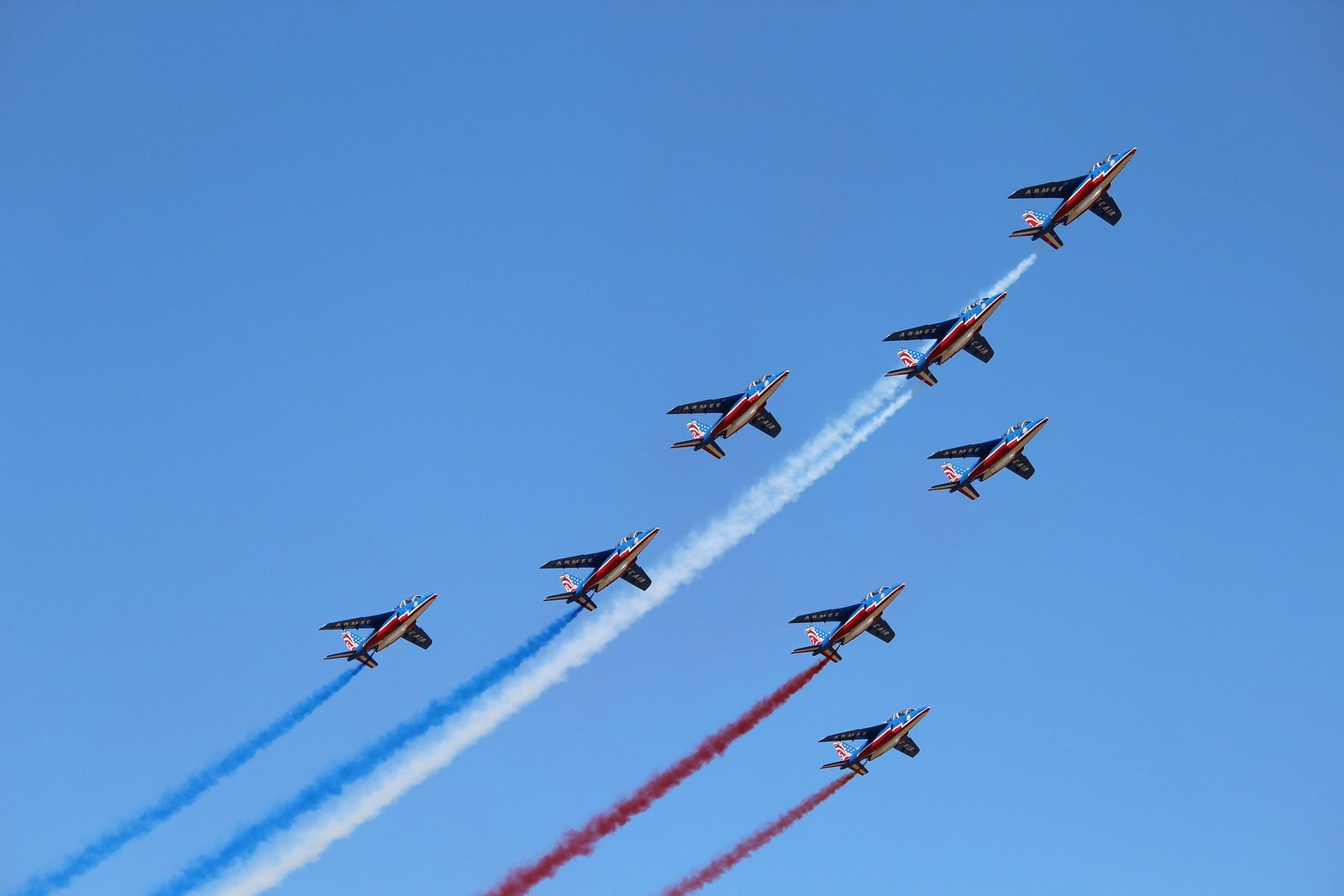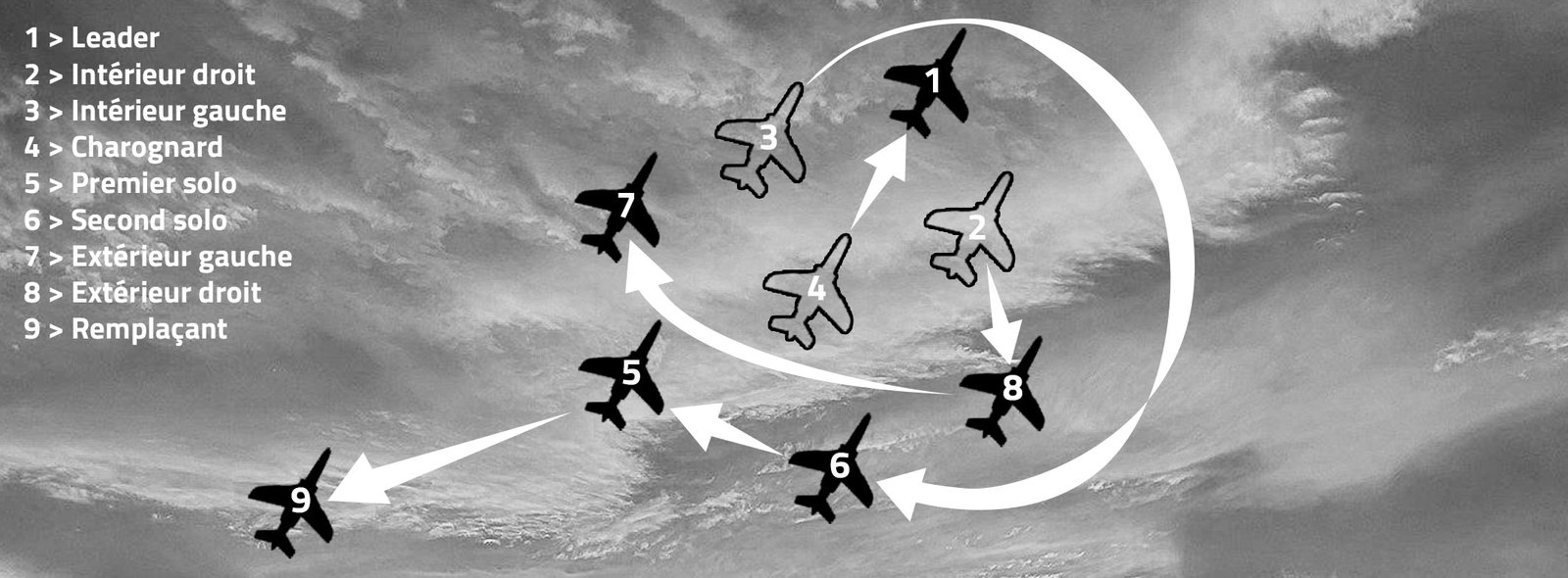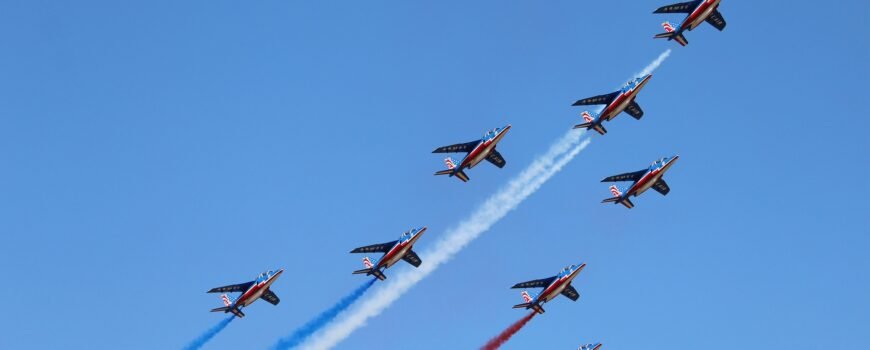The Patrouille de France or Official Acrobatic Patrol of the French Air Force was created in 1953 and is considered one of the best acrobatic formations in the world. Made of nine pilots and of 35 mechanics, its year is broken down into two distinct periods: the winter season, intended for training and summer time where it occurs nearly 50 times a year during air events. Traditionally, the Patrouille Acrobatique de France (otherwise known as PAF) opens the July 14 parade aboard nine of its Alpha Jets. Its premises, located at Salon of Provence for its good weather conditions, allow an optimal number of training sessions between October and March.
We will detail the different cells, the functions and missions of mechanics and pilots, planes and to finish the collaboration between Dimatex and the Patrouille de France.

The different cells
Within the Patrouille de France there are several cells that ensure its proper functioning.
The direction is used to coordinate all the actions incumbent on this unit so that pilots and mechanics are provided with all the means necessary for the successful completion of their missions.
A logistics unit, supported by the operations unit which prepares flight plans, organizes travel and summer outings for the various meetings.
The photo and video cell records all formation flights while taking aerial photographs. The latter works in close collaboration with the communication unit which promotes images and different movements.
Finally, the administration unit ensures the administrative follow-up of each staff member.
Mechanics
The mechanics of the Patrouille de France have different missions and are therefore divided into several groups.
Technical service ensures throughout the year the availability as well as the maintenance of 12 Alpha Jet provided by the Air Force.
The technical office organizes a follow-up of all spare parts in order to plan maintenance.
Each member of the track team, made of nine mechanics (or trackers), chooses a pilot with whom he will form a duo all year round. Namely that the aircraft is considered to belong to the mechanic who lends it to the pilot. This is the reason why both names appear on the Alpha Jet.
A last cell is entirely intended for troubleshooting and ensuring repairs which require significant resources or even downtime. She understands four different poles : vector mechanics, avionics mechanics, service mechanics and armament mechanics.

The pilots
Every year, three new pilots join the team. They are appointed by the PAF pilots in place among the volunteer Air Force fighter pilots. Each must hold the qualification of patrol leader and count 1,500 flight hours minimum on a jet plane.
The pilots generally stay three to five years with the Patrouille de France. These virtuosos of the sky become one during their training and fly within three meters of each other. The flying techniques are very different from those they may have learned before. During their demonstrations, they perform different loops and tricks just 90 meters from the ground at over 1,050 km / h at maximum speed.
Here is a more precise detail of the different roles of the pilots as well as their functions:
– Athos 1, also called the leader, holds office for one year. He is the only pilot who cannot be replaced within the patrol. He is considered the conductor of the patrol and will determine the figures as well as the formations with his team. His position is irreplaceable because during the many training sessions, his teammates rely on his voice and his expectations.
– Athos 2 and Athos 3, more commonly called the interiors, have just joined the Patrouille de France. During their first year, they will work on the second line alongside the leader during meetings and flight training.
– Athos 4, this the scavenger, is located just behind Athos 1. Like Athos 2 and 3, he too has just joined the PAF. This scavenger name is given to him because he receives all the smoke from the leader and will take his place the following year. From his position he will observe the leader in order to analyze his behavior to quickly reach a very high level in order to succeed him.
– Athos 5 is the solo leader and Athos 6 the second solo. The two positions they occupy allow them to leave the training easily in order to perform figures in pairs during the second part of the presentation. Generally Athos 6 will succeed Athos 5 who will be replaced by him.
– Athos 7 and Athos 8 that we call the exteriors, are the furthest from the leader. Their positions in the formation require a lot of anticipation in order to maintain the form of the aerial fort.
– Athos 9 is the replacement, he is the oldest pilot of the Patrol. He held the post of “interior”, “solo leader” and “second solo” in previous years. Athos 9 must be able to replace any patroller except the leader.

Here is a quick explanation of the rotation of different positions From one year to another :
We can see that three new integrate training at the posts of Athos 2, 3 and 4. In addition, some of them will no longer evolve within the formation the following year like Athos 1, 7 and 9.
Athos 1 and 4 are career officers. They are therefore intended to occupy squadron and / or staff command positions in their second part of their careers. Athos 7 and 9 are officers under contract. They will return to operational units at the end of this experience.
Planes
The Patrouille de France has available 12 Alpha Jet, nicknamed “Gadget“since 1981. These small planes are so nicknamed because they are the models on which pilots started their careers.
The Alpha Jet is a two-seater training and ground attack aircraft which made its first flight on October 26, 1973. It has a wingspan of 9.16 meters, a length of 11.85 meters and a height of 4. , 19 meters. Its empty weight is 3,345 kg and has a maximum ceiling of 15,000 meters.
The Alpha Jets saw themselves somewhat modified for the needs of the PAF. A blue, white and red paint was applied to represent the French colors. A smoke pod was placed under the center point of the aircraft and a pipe now connects it to the level of the left rear engine for the exit of smoke. In addition, the sight has been removed to provide better visibility, as it is unnecessary on this type of flight.
The Dimatex / Patrouille de France partnership:
The brand Dimatex and the Patrouille de France have joined forces to create equipment that is perfectly suited to the needs of PAF. These bags and pouches, which you can already find on Vetsecurite.com, have been designed with professionals in order to meet the most specific needs of pilots.
The Matt backpack, iconic model of the Dimatex brand is available in the colors of the Patrouille de France in its classic intervention format as well as in the Matt mini model. You can find an explanatory video dedicated to this bag on our Youtube channel.
Next comes the Braco backpack which is a model intended for backpackers due to its helicopter functionality. This bag will be your greatest friend in extreme situations.
This collaboration also consists of the Master 15 case which will store a 15 ” computer or A4 type documents. You can also combine a Black-line or Full black color carry strap for a more comfortable carry.
Of course, the Cavok clutch is part of this exclusive collection. This thigh pouch, essential for all pilots, is personalized in the colors of the Patrouille de France and will allow you to always have flight instructions or a navigation map with you. The Cavok pouch is also available in a mini model.
This association between Dimatex and the Patrouille de France also includes the Stealth flight bag absolutely essential for all pilots and which will allow you to carry your helmet and store the different effects that are useful to you for each of your flights.
And finally, the JFK duffel bag, which, like all transport bags from the Dimatex brand, can be combined with a Matt bag, thanks to its numerous Duraflex buckles.
Good flight !

Photo credit: Patrouille de France
See the entire Patrouille de France range!

